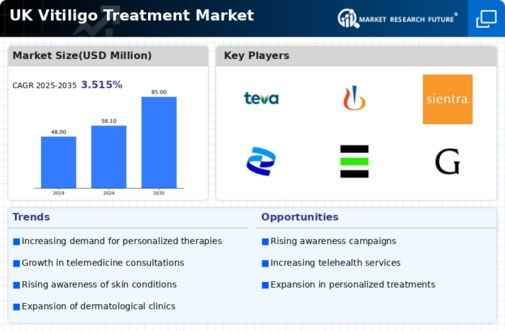Rising Incidence of Vitiligo
The increasing prevalence of vitiligo in the UK is a notable driver for the vitiligo treatment market. Recent studies indicate that approximately 1-2% of the population is affected by this skin condition, leading to a growing demand for effective treatment options. As awareness of the condition rises, more individuals are seeking medical advice and treatment, thereby expanding the market. The rising incidence is particularly evident among younger populations, which may lead to a sustained increase in treatment demand over the coming years. This trend suggests that healthcare providers and pharmaceutical companies may need to adapt their strategies to cater to this growing patient base, ultimately influencing the dynamics of the vitiligo treatment market.
Rising Mental Health Awareness
The growing recognition of the psychological impact of vitiligo is driving demand for comprehensive treatment options within the vitiligo treatment market. Patients often experience emotional distress due to the visible nature of the condition, leading to increased awareness of the need for holistic treatment approaches. Mental health support services are becoming more integrated into dermatological care, reflecting a shift towards addressing both physical and psychological aspects of vitiligo. This trend may encourage more patients to seek treatment, thereby expanding the market. As mental health awareness continues to rise, it is likely that the vitiligo treatment market will evolve to include a broader range of therapeutic options.
Increased Healthcare Expenditure
The rise in healthcare expenditure in the UK is a crucial driver for the vitiligo treatment market. With the National Health Service (NHS) allocating more funds towards dermatological conditions, patients are gaining better access to treatment options. Reports indicate that healthcare spending has increased by approximately 4% annually, which may lead to improved availability of therapies for vitiligo. This financial commitment from the government not only enhances treatment accessibility but also encourages pharmaceutical companies to invest in the development of new products. Consequently, the increased healthcare expenditure is likely to stimulate growth in the vitiligo treatment market, benefiting both patients and providers.
Innovative Research and Development
Ongoing research and development in the field of dermatology are significantly impacting the vitiligo treatment market. Pharmaceutical companies are investing heavily in innovative therapies, including biologics and gene therapy, which show promise in treating vitiligo. For instance, recent advancements in targeted therapies have demonstrated efficacy in repigmenting the skin, which could potentially transform treatment protocols. The UK government has also been supportive of research initiatives, providing funding and resources to encourage innovation. As new treatments emerge, they are likely to enhance patient outcomes and expand the market, attracting both patients and healthcare providers to explore these novel options.
Growing Demand for Personalized Medicine
The shift towards personalized medicine is reshaping the vitiligo treatment market. Patients are increasingly seeking tailored treatment plans that consider their unique genetic and environmental factors. This trend is supported by advancements in genetic research, which have identified specific biomarkers associated with vitiligo. As healthcare providers adopt more personalized approaches, the market is expected to expand, with treatments becoming more effective and targeted. This evolution in treatment philosophy aligns with the broader movement towards individualized healthcare, suggesting that the vitiligo treatment market may experience significant growth as providers adapt to meet these changing patient expectations.





















Leave a Comment